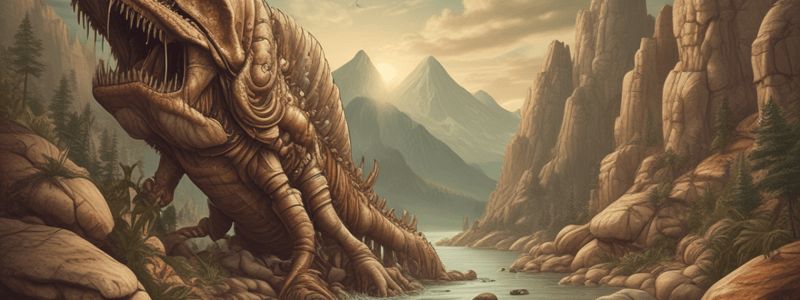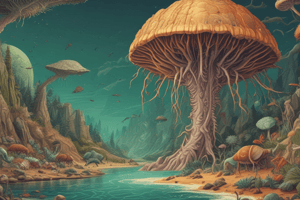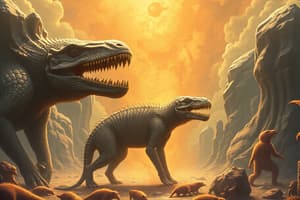Podcast
Questions and Answers
What is the proposed role of Hox genes and other genetic changes in the evolution of new body forms?
What is the proposed role of Hox genes and other genetic changes in the evolution of new body forms?
- They led to the extinction of arthropods
- They facilitated the origin of vertebrates
- They affected the regulation of developmental genes (correct)
- They triggered the Cambrian explosion
What is the significance of fern galls in understanding the evolution of insects and plants?
What is the significance of fern galls in understanding the evolution of insects and plants?
- They demonstrate the influence of insects and plants on each other's evolution (correct)
- They mark the origin of amphibians
- They indicate the diversification of arthropods
- They provide evidence of vertebrate evolution
What is the significance of the Cambrian period in animal evolution?
What is the significance of the Cambrian period in animal evolution?
- It is a period of stable evolution
- It is a period of rapid animal diversification (correct)
- It is a period of mass extinction
- It marks the origin of vertebrates
What is the distinction between amphibians and amniotes?
What is the distinction between amphibians and amniotes?
What is the estimated time when vertebrates transitioned to land?
What is the estimated time when vertebrates transitioned to land?
What is the inferred relationship between arthropods and terrestrial habitats during the Cambrian period?
What is the inferred relationship between arthropods and terrestrial habitats during the Cambrian period?
What is the primary characteristic that distinguishes animals from plants and fungi?
What is the primary characteristic that distinguishes animals from plants and fungi?
Which of the following is a key feature of animal development?
Which of the following is a key feature of animal development?
What is the term for the process by which animals develop body form and structure?
What is the term for the process by which animals develop body form and structure?
Which of the following time periods is characterized by the diversification of mammals?
Which of the following time periods is characterized by the diversification of mammals?
What is the term for the description of an animal's overall body structure and organization?
What is the term for the description of an animal's overall body structure and organization?
Which of the following types of symmetry is characteristic of some animals?
Which of the following types of symmetry is characteristic of some animals?
What is the primary difference between the formation of coelom in protostome and deuterostome development?
What is the primary difference between the formation of coelom in protostome and deuterostome development?
What is the term for a group of organisms that share a common ancestor and all of its descendants?
What is the term for a group of organisms that share a common ancestor and all of its descendants?
Which of the following phyla is characterized by radial symmetry and diploblastic body structure?
Which of the following phyla is characterized by radial symmetry and diploblastic body structure?
What is the term for animals that have true tissues?
What is the term for animals that have true tissues?
According to the phylogenetic trees, what is the relationship between sponges and other animal lineages?
According to the phylogenetic trees, what is the relationship between sponges and other animal lineages?
What is the common characteristic shared by worms, humans, and most other triploblasts, despite their differences in specific anatomy?
What is the common characteristic shared by worms, humans, and most other triploblasts, despite their differences in specific anatomy?
What is the primary function of hemolymph in the body cavity of certain triploblastic animals?
What is the primary function of hemolymph in the body cavity of certain triploblastic animals?
What is the key difference between radial cleavage in deuterostomes and spiral cleavage in protostomes?
What is the key difference between radial cleavage in deuterostomes and spiral cleavage in protostomes?
What is the term for the blind pouch that forms during gastrulation and eventually becomes the gut?
What is the term for the blind pouch that forms during gastrulation and eventually becomes the gut?
What is the common ancestor of all animals, according to the current understanding of animal phylogeny?
What is the common ancestor of all animals, according to the current understanding of animal phylogeny?
What is the characteristic that distinguishes Eumetazoa from other animals?
What is the characteristic that distinguishes Eumetazoa from other animals?
In which group of animals does the blastopore become the anus?
In which group of animals does the blastopore become the anus?
Flashcards are hidden until you start studying
Study Notes
Body Cavity and Development
- A coelom is a body cavity surrounded by tissues derived from mesoderm, which forms structures that suspend internal organs.
- A hemocoel is a body cavity formed between the mesoderm and endoderm, filled with hemolymph that transports nutrients and waste throughout the body cavity.
- Some triploblastic animals lack a body cavity, being compact with thin, flat bodies that exchange nutrients, gases, and wastes across the body surface.
Protostome and Deuterostome Development
- Protostome development is characterized by spiral and determinant cleavage, where cell fate is rigidly determined early on.
- Deuterostome development is characterized by radial and indeterminate cleavage, where each cell produced by early cleavage can form a complete embryo.
Coelom Formation
- Coelom formation occurs during gastrulation, where the embryo forms a blind pouch, the archenteron (which becomes the gut).
- In protostome development, the coelom forms from the splitting of solid masses of mesoderm.
- In deuterostome development, the coelom forms from the mesoderm budding from the wall of the archenteron.
Fate of the Blastopore
- The blastopore is an indentation in the gastrula that leads to the formation of the archenteron.
- In protostome development, the blastopore becomes the mouth.
- In deuterostome development, the blastopore becomes the anus.
Animal Phylogeny
- By 500 million years ago, most animal phyla with members alive today were established.
- Multiple data sources, including whole genomes, morphological traits, rRNA genes, Hox genes, protein-coding nuclear genes, and mitochondrial genes, are used to infer evolutionary relationships among animal phyla.
Diversification of Animals
- All animals share a common ancestor.
- Sponges are the sister group to all other animals.
- Eumetazoa is a clade of animals with tissues, including all animals except sponges and a few others.
- Most animal phyla belong to the clade Bilateria.
- Bilateria includes both invertebrates and vertebrates, with Chordata being the only phylum that includes vertebrates.
Studying That Suits You
Use AI to generate personalized quizzes and flashcards to suit your learning preferences.




